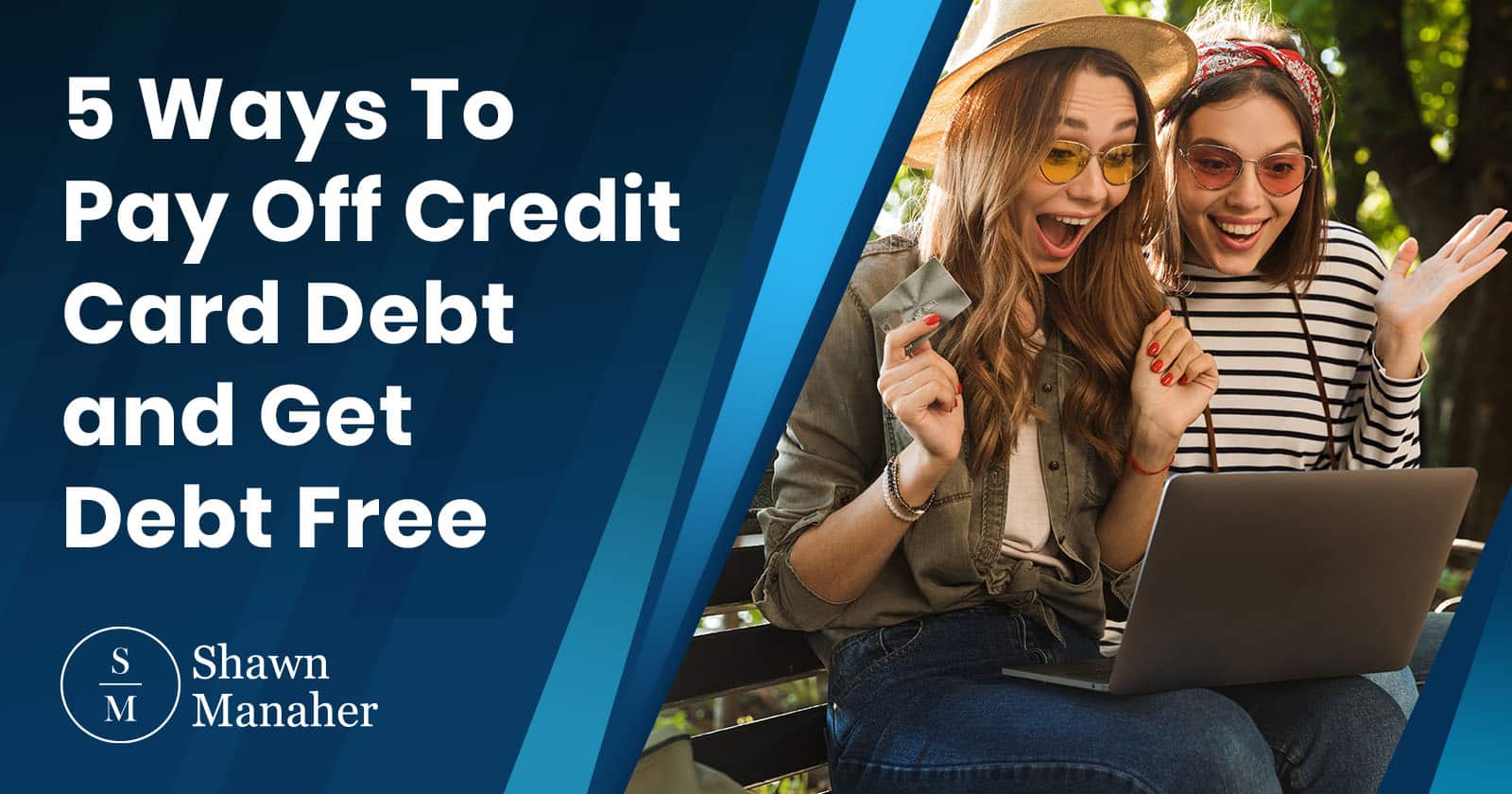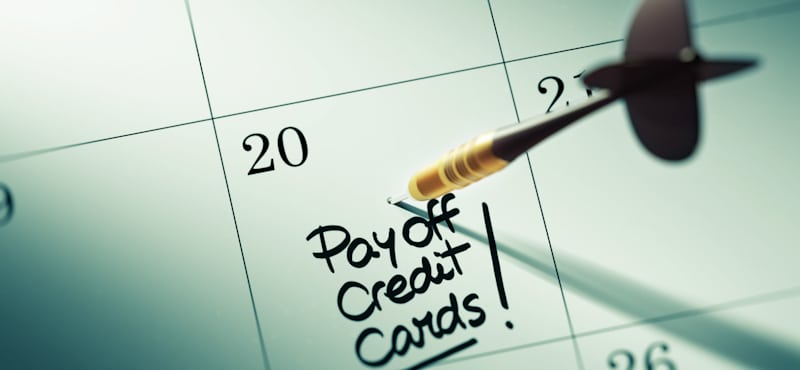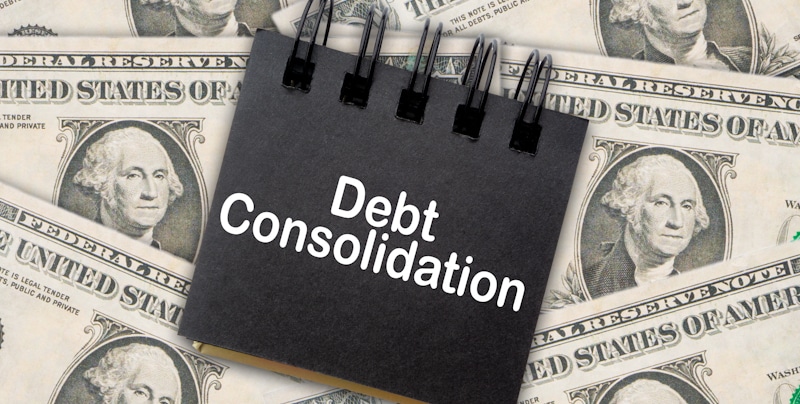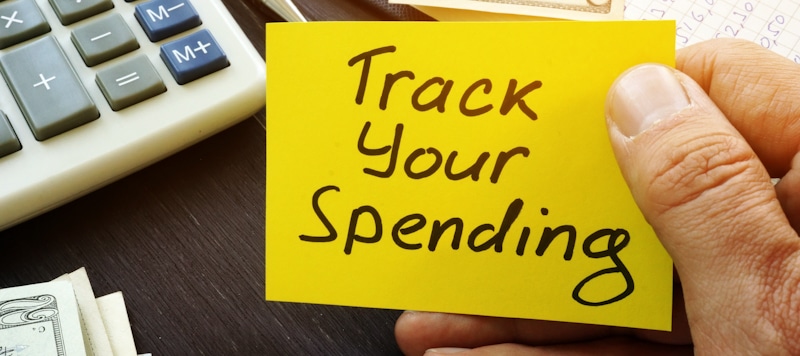

Credit cards have become a way of life.
People are used to the idea of being in debt and financing their lives and lifestyle through a continuous cycle of debt, all in the form of an easy-to-use credit card. Or two. Or five.
The issue is that using a credit card makes spending easier and harder to stick to your budget. Plus, since banks are incentivized to let users carry a balance and give frequent credit card users high credit limits, it’s easy to spend your way into deep debt.
If you’re wondering how to pay off credit card debt, you’re not alone. In Q1 of 2022, the average cardholder had $5,769 in credit card debt on their card, which doesn’t account for other kinds of debt or cardholders with more than one credit account.
That’s a lot of debt to be living under!
The good news is that debt doesn’t have to be the answer, and you can break free of your credit card debt. Here’s how:

This path to overcoming credit card debt mirrors what I did for myself, getting rid of debt and learning how to be a successful serial entrepreneur online. If I can do it, so can you!
The first step to overcoming credit card debt, and any kind of debt, is to understand how much debt you’re in and how that debt operates. Remember, debt isn’t a static number. Your spending, monthly interest, and other fees and charges can all increase how much debt you’re in.
Depending on the cards you own, your debt might not function like your friends’ debt. Your credit rating, how many credit cards you have, and the interest rates you’re working with all matter.
Getting a solid understanding of your debt is the first step in getting your credit card debt under control. So, take a day to look over all of your accounts. Make sure you get a few key pieces of information for each credit card you own:
Once you have all that information, take note of which account has your highest balance and which account has the highest interest rate.
Now that you know what your credit card debt looks like, you’re ready to start creating a plan for managing it.
Remember, if you’re hoping to get out of debt, you need to make at least the minimum payment + the amount of any recurring charges on each card every month. Your real debt reduction minimum payment is the minimum required payment + the cost of all recurring charges. Figure out what that number is for each of your cards as they are now.
Remember, it can feel overwhelming to look at all of your debt this way, but it will make your credit card debt more manageable in the long run. Don’t worry, the next steps in my plan for how to pay off credit card debt will help you minimize how much you need to pay and make payment easier to manage.
The next step is to see what kind of accounts are available to you right now.
We’ll be honest. You’ll probably have better refinancing and balance transfer opportunities if your existing credit score is pretty good. However, even if your credit is bad, this tip can still help make your credit card payments easier to manage.
The trick in this step is looking for good opportunities to temporarily or permanently lower your interest rates and take advantage of special offers to reduce your overall debt load.
If you have more than one credit card, this step is particularly important.
What you’re looking for are credit card offers that come with either lower interest rates than your current credit cards or that have an introductory 0% interest 0% APR rate and a comparable interest rate to your current cards.
Looking at the final APR and interest rate for these cards is critical. The last thing you want to do is sign up for a balance transfer card that you won’t be able to pay off before the interest rate kicks in, only to discover that your interest rates are significantly higher than they used to be.
You should also look at your existing credit cards and see if you can do a balance transfer from your highest-interest card onto your lowest-interest card. It won't always be possible to lower your interest rates without opening a new credit account, but it's worth checking.
Remember, you aren’t actually consolidating your debt yet. This is all about getting as much information about your options as possible.
You can also look at personal loan opportunities to see if you might qualify for a loan with a lower interest rate than your existing credit cards. These deals are relatively rare, so don’t be surprised if there aren’t any good options, but again, the more information you have, the easier it will be to make an effective plan to get out of debt.
Once you know what kinds of balance transfer cards or personal loans are available to you, look for 1-2 options that will let you consolidate your debt into lower interest payments. Highlight these options for step 3.
You need to know what the maximum balance transfer is for each possible balance transfer card or personal loan you choose. Hopefully, you won't need the maximum, but this is key to consolidating your debts well.

Now that you have the information you need to start planning and creating a budget moving forward, it’s time to take the first active steps toward eliminating your credit card debt.
The goal of this step is to have as few different monthly payments as possible and to consolidate as many payments as you can into the lowest possible interest rates.
That being said, there is one exception. If you found good balance transfer offers that give you 12-24 months of 0% interest 0% APR, and you have card balances you could reasonably pay off within that introductory rate period, you might want to use those opportunities, even if the interest rate after the introduction is higher. The key to doing this well is to only move balances you know you can pay off before the higher interest rate kicks in.
Keeping the balance on these cards low enough that you can pay them off in time can justify having more payments you need to make each month. Budgeting is the next step once you've consolidated payments down as much as possible – but you can use your existing budget to help figure out how much money you can put toward the debts on these balance transfer cards.
Look at what you're currently paying on your higher-interest cards and do the math for how much those payments will let you pay off during the introductory rate term. If it’s equal to or more than the balance you’d transfer onto the card, it’s probably a good idea. If your payments aren't able to eliminate the debt, you are probably better at consolidating using other offers.
Next, choose the lowest interest consolidation option. If you're using a balance transfer card, move the maximum amount of your debt onto the card, starting with your highest-interest debt. Your minimum payments may be higher than the individual payments from your other cards this way, but those payments will be more effective, and will help you get out of credit card debt faster.
Continue this process the same way until your debt is consolidated into the minimum number of payments and concentrated in the accounts with the lowest possible interest rate.
You might have been surprised that budgeting and creating a debt payment plan didn’t happen earlier in this list. Essentially, we’re assuming that you already have a working budget and trying to prevent you from doing the same work twice. Now that your debt is consolidated and you have fewer payments (and hopefully lower payments), you can create a budget that's accurate for your new financial situation.
If you don’t already have a budget or a personal finance plan, consider that step 0.
Not sure how to make or update your financial plan?
Never fear!
Our 7 Steps To Creating A Personal Finance Plan For Your Future will help you get started.
Now there are two basic methods for paying off credit card debt we recommend. Both methods work, but you need to stick to them and use them to inform your budgeting.
Here are the two credit card debt payment strategies we recommend:
Snowball Method: The snowball method involves paying off your lowest balance debt first, then rolling the payments you made on that debt into the payments for the next largest debt, and so on, until you are debt free.
The Avalanche Method: This method is designed to make your dollars have a bigger impact. It involves starting with paying off your highest-interest debt first, regardless of whether that’s your smallest or largest balance. Like the snowball method, once your highest-interest debt is paid off, you'll add that payment amount to your next highest-interest debt, and so on, until you’re debt free.
The snowball method can work well if you have several accounts with largely similar interest rates. However, the avalanche method is generally better for most people, especially if you have a range of interest rates across your debt. The higher the interest on your highest account, the more important it is to pay off high-interest debt first.
Remember, regardless of which method you choose, your budget must include paying at least the required minimum on all of your accounts. Ideally, you should be paying your debt-reduction minimum, which includes all of the recurring charges on each account in addition to your minimum payments on all accounts, and more than that on the account you’re paying off first.

The last step is to track your spending and give yourself more wiggle room by eliminating the extras. This last step is often where people both start and stop their budgeting, which is part of why it often doesn’t work.
If you constantly feel like you’re denying yourself the things you want and enjoy, it will be difficult to stick to your budget and debt payment plan.
So, while eliminating unnecessary expenses is important, you also need to give yourself a little wiggle room to keep the things you enjoy.
For instance, if you have a lot of streaming service subscriptions, you can probably save some money by choosing the 1-2 subscriptions that matter most to you and cutting the others. If a show you're excited about releases on a different platform, you can always get rid of one of your current subscriptions and replace it with the new one. In this case, the answer isn’t to stop subscribing to streaming services entirely. Just eliminate the extra spending you don’t really need.
This is an ongoing process, and you should check in on your spending habits relative to your budget every few months until your spending stabilizes and lands on a happy medium between reducing spending and still being able to relax and enjoy yourself.
Remember that the reason you’re doing this isn’t just to keep an eye on your spending and make sure you stick to your budget. It’s also about developing a sense of how much things cost, how much wiggle room you have in your finances, and learning to remember how much you’ve been spending over time.
Having a sense of where your money goes, what you splurge on, and where you need to watch the budget most closely will make it easier to stay in control of your finances and on schedule in your debt repayment plan.
Debt can often feel inevitable. You might feel trapped in debt cycles or like there aren't any good ways out of the debt you're already in. It’s understandable to feel that way, but you also need to know that those feelings aren’t reality.
The truth is that you can live debt free. Yes, you. It might take some work to get there, and getting rid of credit card debt is just part of the equation. But, with dedication and determination, it is possible.
Not sure what your next steps should be after creating a plan for your credit card debt? Take a look at our 25 Money Management Tips – these tips are designed to help you take control of all aspects of your personal finances, create a plan for your financial future, and eliminate debt, and the need for debt, from your life.

